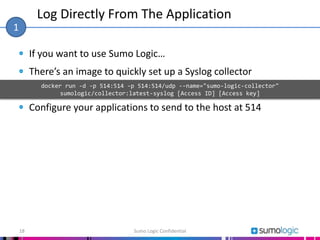

- DOCKER SYSLOG HOST HOW TO
- DOCKER SYSLOG HOST WINDOWS 10
- DOCKER SYSLOG HOST PASSWORD
- DOCKER SYSLOG HOST FREE
DOCKER SYSLOG HOST FREE
Splunk Light is free if you need to index less than 500Mb, which will be more than enough for home use.

I could not find anything which just works out of box, so I decided to start working on my own solution, which is built on top of Splunk Light. So I wanted to use something like cadvisor, but with historical information and also attached logs for the containers. I did not want to use cloud solutions, because they can also upload some sensitive information, like environment variables, where I could keep passwords for AWS backups. There are plenty of great tools which allow you to monitor your docker environments, like cadvisor and some other cloud solutions. You cannot really feel safe for the services you run if you don’t monitor them. Everything I did here – I did only for my personal needs and my free time. I have some knowledge about Splunk obviously, but you should not consider this as an official Splunk manual. Once the pihole/pihole image is downloaded on your machine, the command automatically continues and follows the parameters you set in the command.I’m working at Splunk, but this is my personal thoughts. Tells the docker run command to use the official pihole/pihole base image from Docker hub.īelow, you can see the command pulls the pihole/pihole base image from Docker Hub. Sets a restart policy so the Docker container always restarts unless it is manually stopped by the user. Maps the ports of host machine to the ports of the Docker container (port 81 in host machine maps to port 80 of Docker container) Mounts the volume dns_config and use subdirectory /etc/dnsmasq.d for storing DNS configurations as required. Mounts the volume pihole_app and use subdirectory /etc/pihole for storing the Pi-hole files You will use this again later for making Pi-hole work. Set your IP address for the Docker container.
DOCKER SYSLOG HOST PASSWORD
Sets a password for the Pi-hole interface. Asia/Manila was used for this tutorial, but you can input anything that has the same format listed in on a GitHub gist.

There will be an error if a container with the same name already exists on your machineĮnvironment variable for time zone. You can also change the names according to your preference.ĭocker run -name=pihole -e TZ=Asia/Manila -e WEBPASSWORD=password -e SERVERIP=YourIPAddressHere -v pihole_app:/etc/pihole -v dns_config:/etc/dnsmasq.d -p 81:80 -p 53:53/tcp -p 53:53/udp -restart=unless-stopped pihole/pihole Pi-hole Docker Command Flags Command Flags Open PowerShell as administrator, then run the below commands for Docker to create two volumes ( volume create) named pihole_app and dns_config.
DOCKER SYSLOG HOST HOW TO
Related: How to Create (and Manage) Docker Volumes on Windows When setting up Pi-hole in Docker container, you’ll first need to create a Docker volume to store the Pi-hole application and DNS configuration.
DOCKER SYSLOG HOST WINDOWS 10



 0 kommentar(er)
0 kommentar(er)
